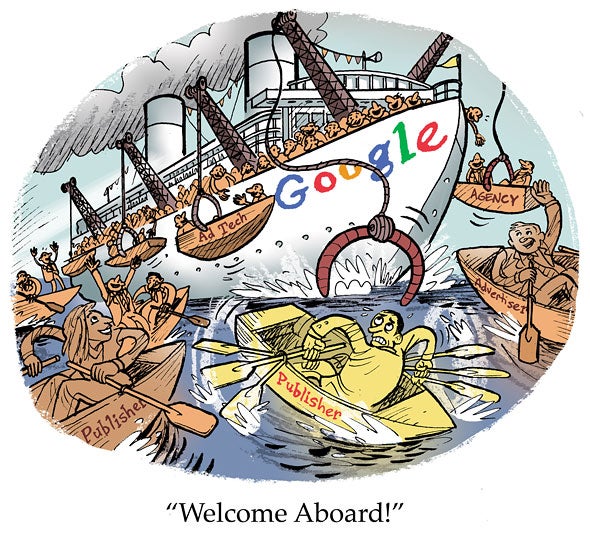By next year, Google will have three separate business lines – Search, YouTube and Cloud – that each generate roughly twelve digits per year.
That’s around $100 billion apiece.
To put this into perspective, it took 15 years for Google to grow into a $100 billion per-year business – and just six years to triple its annual revenue to more than $300 billion, CEO Sundar Pichai told investors during the company’s Q1 2024 earnings call on Thursday.
But despite their growth, YouTube and Cloud aren’t even the main contributors to Alphabet’s overall revenue growth. That title still belongs to Google Search, the undisputed, undefeated heavyweight champion of printing cash.
Yet Google Search is changing thanks to generative AI – and Alphabet is playing the long game when it comes to monetization.
Meanwhile, Alphabet’s earnings revealed revenue is still declining at Google’s ad network business.
The Alphabet money machine
In Q1, Alphabet earned a total of $80.5 billion, up from $69.8 billion a year ago.
That’s 15% growth – although percent-based growth hardly works in Google’s case, considering 15% would be a perfectly healthy growth rate for a company generating hundreds of millions of dollars per year, while Google only added a little over $10 billion in net new dollars.
Google’s Q1 profit, which was $15 billion a year ago, totaled more than $23.6 billion in 2024.
It was a solid quarter and investors were happy. In after-hours trading, shares of Alphabet stock soared from $158 to around $176. That jump in the stock price represents an increase of more than $100 billion in Alphabet’s market cap. The company is now worth more than $2 trillion for the first time.
And why wouldn’t investors love the news?
Aside from the crazy revenue growth, Alphabet also announced its first-ever dividend, awarding all shareholders with a 20-cent payout per share. Plus, there’s a new $70 billion share buyback program. (Investors get excited about this type of expenditure because it drives up the value of their shares. The market cap stays the same and there are fewer shares on the market).
Google’s only loser, so to speak, was the Google network business serving ads across other sites and apps. Google network revenue ticked down once again year over year, from $7.5 billion in Q1 2023 to $7.4 billion this year.
Publishers on the Google network are, on average, seeing revenue dwindle. At the same time, companies such as The Trade Desk, not to mention smaller public ad tech businesses like PubMatic, Viant and Magnite, are growing their open web revenue. This implies that Google’s third-party ad tech is losing out in the market to independent programmatic competitors.
But Google Cloud added more than $2 billion in revenue over the past year and Google’s subscription businesses grew by $1.3 billion. And YouTube ads? Up $1.4 billion. Google Search revenue increased by a cool $6 billion.
And so nobody at Google or within the investor ranks seems all that fussed about the ad network decline.
Google’s growth opportunities
Yet despite Google’s breakneck revenue growth in general, there are actually several areas where monetization still needs to catch up with organic growth.
One is generative AI and other new forms of search, such as someone conducts a search by taking a picture on their phone. And another is YouTube Shorts.
“We’ve always found that over many years when things will work well on the organic side, monetization follows,” Google Chief Business Officer Philipp Schindler told an investor in answer to a question about earning more from overall query growth, since many new forms of search aren’t yet ad-supported.
“There are questions about monetization,” Pichai acknowledged to another investor who asked about search query growth. “And based on our testing so far, I am comfortable and confident that we’ll be able to manage the monetization transition here well.”
One reason why investors like Google is because they believe in the company’s ability to monetize organic opportunities over time.
YouTube Shorts – bite-size videos akin to TikTok – were made available in 2021. Since then, Google has navigated uncomfortable questions from investors who are disconcerted by minimal monetization despite high organic engagement with Shorts, including the number of posts and total views.
But, at last, YouTube Shorts is starting to introduce more ad opportunities. Schindler said the monetization rate for Shorts is more than double that of in-stream viewing (as in, typical YouTube consumption), and improved by 10 points sequentially, which means growth is coming month over month, not just year over year.
“We’re very focused on the monetization opportunity,” CFO Ruth Porat told one investor who asked about managing high cloud costs for new advertising and generative AI products that still earn relatively little.
Monetization underlies “everything that we’re doing in Google Services and Google Cloud,” she said. “At the same time, we’re very focused on the efficiency of all elements of delivering that compute capacity from hardware, software and beyond.”




















